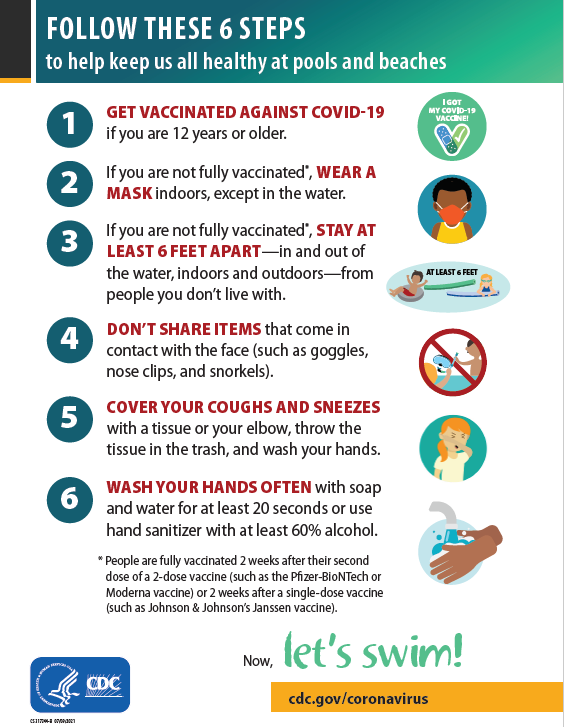Aquatics FAQs
Recommendations for Fully Vaccinated People
COVID-19 Homepage
Frequently Asked Questions from Operators or Managers of Pools, Beaches, Waterparks, and other Aquatic Venues
How can I reduce the risk of staff and visitors getting and spreading COVID-19 at my aquatic venue when not everyone is fully vaccinated?
Follow any federal, state, local, tribal, or territorial laws, in collaboration with local health officialsexternal icon.
- Promote vaccination for those eligible and partner with vaccine providers (such as pharmacies; healthcare providers; or the state, local, tribal, or territorial health departments).
- Lifeguards who are fully vaccinated have the best available protection against COVID-19 when performing rescues, cardiopulmonary resuscitation (CPR), or first aid during which physical distancing cannot be maintained.
- Communicate about COVID-19 prevention steps through signage around the venue and on flyers, emails, etc.
- Encourage those who are not fully vaccinated to wear masks consistently and correctly and stay at least 6 feet apart (see also How can I encourage safe mask use and physical distancing at my aquatic venue?).
- Discourage people who are not fully vaccinated from sharing items that are meant to come in contact with the face (such as goggles, nose clips, and snorkels).
- Everyone should cover coughs and sneezes and wash hands.
- Support case investigations and contact tracing.
- Clean and disinfect.
- Improve ventilation.
- Follow Guidance on Mitigating and Preventing the Spread of COVID-19 in the Workplaceexternal iconexternal iconexternal icon.
How can I encourage safe mask use and physical distancing at my aquatic venue?
Encourage people who are not fully vaccinated to use masks indoors, except in the water.
- Discourage staff and visitors from wearing masks in the water.
- Encourage people who are not fully vaccinated to bring extra masks in case the ones they are wearing get wet.
- Consider having additional masks on hand in case people forget their masks or need to replace wet masks.
- Remind staff and visitors that goggles, SCUBA masks, and other such masks should not be used to protect against COVID-19. Choose a mask that helps protect you and others from getting and spreading COVID-19.
Encourage people who are not fully vaccinated to maintain physical distancing. Physical distancing means staying at least 6 feet apart from people you do not live with, and applies both in and out of the water. Six feet is a few more inches than a typical pool noodle.
- Provide physical barriers and guides (such as tables, chairs, and umbrellas in the sand or on the deck) and visual cues (such as posted signs or tape or decals on floors or sidewalks) to encourage people who are not fully vaccinated to maintain physical distancing—in and out of the water. For pools, lane lines can be used in the water.
- Stagger use of shared spaces (such as limiting the number of people in the water and potentially enclosed spaces such as bathrooms, locker rooms, and breakrooms).
- Review federal, state, local, tribal, or territorial limits on gathering size and ensure compliance when hosting an event (such as swim meets and other sports competitions or beach or pool parties).
Exceptions to physical distancing include the need to
- Rescue a distressed swimmer, perform CPR, or provide first aid.
- Evacuate the water or the entire beach or facility because of an emergency.
How can I improve ventilation at my aquatic venue?
Follow these steps for improving ventilation of indoor spaces. Along with other prevention steps, proper ventilation can reduce the concentration of virus particles in the air.
- Increase the percent of outdoor air as high as possible while maintaining acceptable temperature and humidity control.
- Consider other steps to increase the introduction and circulation of outdoor air as much as possible, including changing the air handling system’s time clock to introduce code ventilation 24 hours per day (no off cycle).
- Improve central air filtration to as high as possible without substantially reducing airflow.
- When events (such as swim meets and other sports competitions or pool parties) are scheduled to occur and if the air handling system has a purge mode, consider running a purge sequence starting 3 hours before the event. Turn the system back to normal ventilation 1 hour before the event to allow environmental stabilization. Run the purge mode again for 2 hours after the event.
Checklist for Staff at Aquatic Venues
Daily checklist for staff of public pools, hot tubs, water playgounds, and beaches.
File Details: 223 KB, 1 page
6 Safety Steps
Follow these 6 safety steps to keep us all healthy at aquatic venues.
File Details: 170 KB, 1 page

